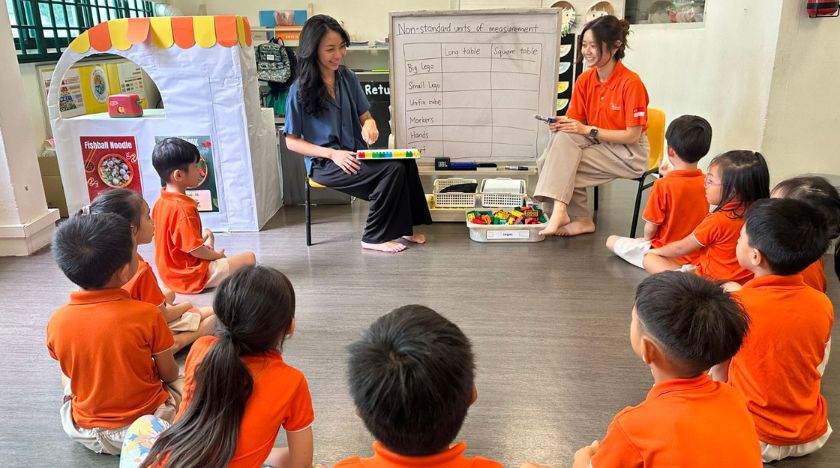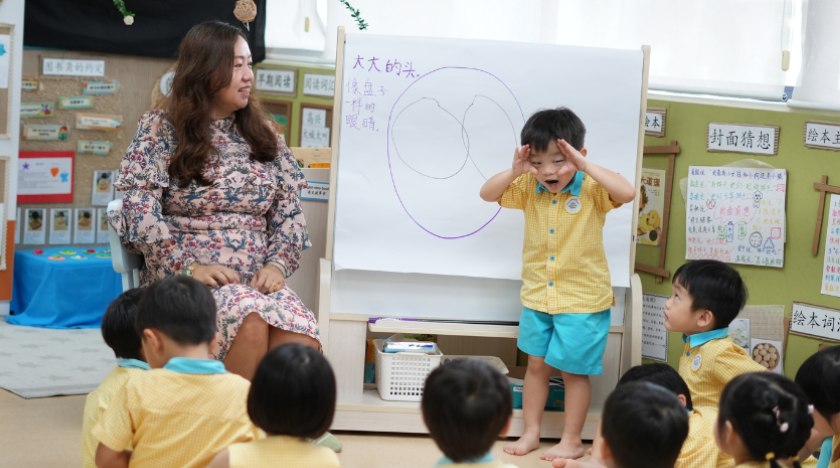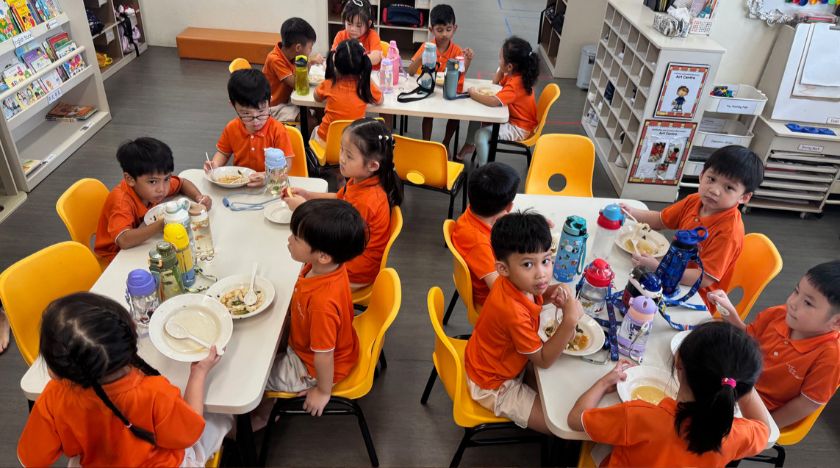![]()
![]()
Tips for Dealing with Preschool Tantrums
PUBLISHED
21 October 2024

Picture this: You’re at the supermarket, and your 3-year-old suddenly starts screaming because you won’t buy them a snack. You’re embarrassed and don’t know what to do, and you feel like everyone is looking at you. If this sounds familiar, you’re not alone. A large study of 1,490 children aged 3-5 found that 84% of children had thrown a tantrum in the last month. However, only 4% of children had daily tantrums. Interestingly, tantrums were most common in 3-year-olds and decreased as children got older.1
Tantrums in preschool are a normal part of early childhood. They can be challenging, but knowing how common they are and why can help you manage them better. This post will give you practical tips and strategies to navigate and survive these crazy moments. Whether you’re dealing with occasional outbursts or more frequent episodes, this will help you support your child through their emotional journey.
Understanding Preschool Tantrums
Tantrums are emotional outbursts that can include crying, screaming, stomping, and even physical aggression. They are a normal part of childhood, especially for preschoolers who are still learning to navigate their emotions and communicate their needs. Tantrums happen because young children often lack the words or self-regulation skills to express their frustrations or wants in a more controlled way.
Several things can trigger tantrums in preschoolers. Frustration is a common cause, especially when a child can’t complete a task or get what they want. Hunger and tiredness can also lower a child’s frustration tolerance and make them more likely to blow up. Overstimulation from a busy environment or too many activities can also overwhelm a young child and cause a meltdown.

Common Examples of Difficult Behaviour
One of the most common behaviours is clinginess. 2 Your child might get upset when you’re out of sight and cry when you leave them, making daily preschool drop-offs a nightmare. To manage this, give them lots of hugs and cuddles to calm their fears. Tell them you love them even when you’re not physically there. Also, identify and address any other sources of anxiety, like a difficult teacher or a classmate who bullies them.
Possessiveness is another behaviour you might encounter. At this age, children refuse to share toys or play with others and seem self-absorbed. To handle this, play with them at home and teach them about sharing and taking turns. Tell them their toys will be returned after others play with them. Help them understand how to play nicely, and praise them when they try to share.
Your child may also throw tantrums when frustrated or can’t express themselves as they want independence and control. To manage this, stay calm and don’t react with anger. Teach them words to express their needs instead of crying or screaming. Explain why certain behaviours are not allowed and give them time to calm down, but don’t reward tantrums with too much attention. Giving them choices can provide them with a sense of control. Recognise that tantrums may be due to tiredness or distress and pay attention to their habits and temperament.
Whining is another behaviour toddlers use to get attention. Stay calm when they start whining; it’s a way to express frustration. Find out why they’re whining and explain why it’s not allowed. Don’t give in to stop the behaviour from being reinforced. Show them consistently that whining is not allowed and teach them calm ways to express themselves, and use humour to help.

How to Prevent Temper Tantrums Before They Start
Establishing consistent routines is key to stability and predictability in a child’s day. When they know what to expect, they feel more secure and less likely to get frustrated or overwhelmed. Setting clear and reasonable boundaries for behaviour helps them understand what’s expected of them and reduces tantrums.
Another way to prevent tantrums is to build a sense of trust and safety with caregivers, as attachment theory says. When children feel securely attached to their caregivers, they feel safe and understood, which can reduce anxiety and frustration. Building this trust means responding to your child’s needs with empathy and patience and creating a nurturing environment where they feel seen and heard. When children feel safe with their caregivers, they will seek comfort and guidance in moments of distress, which can help de-escalate tantrums before they even start.
Make sure children get enough sleep and nutrition. Well-rested and well-fed children can handle stress and frustration better and are less likely to have an emotional meltdown.
Finally, praising and rewarding good behaviour can help children internalise good habits and reduce tantrums. Effective praise goes beyond generic comments and focuses on specific actions. For instance, instead of saying “Good job”, try saying,
- “I saw you took deep breaths and asked for help when you were feeling frustrated. That was a great way to handle your feelings.”
- “You used your words to tell me how you were feeling instead of yelling. Well done.”
- “You were so good at playing quietly while we were waiting. You were very patient.”
When children see their efforts acknowledged, they will continue with those behaviours independently.

How to Deal with Toddler Tantrums When They Happen
When a tantrum happens, parents need to stay calm to avoid escalating the situation.
Take deep breaths and speak in a soft voice. This can help maintain a calm atmosphere. This approach not only helps parents manage their own stress but also models calming behaviour for the child. Children often mirror the emotional states of those around them, so a calm and composed parent can help de-escalate the child’s emotional intensity.
Use distraction techniques, such as offering a favourite toy or suggesting a different activity, to defuse the tantrum before it gets full-blown.
Acknowledge your child’s feelings, too; you can say, “I see you’re really upset because you can’t have that toy”, so they feel heard and comforted.
But set firm but gentle boundaries. While it’s important to empathise, don’t give in to demands to prevent reinforcing tantrum behaviour.
Sometimes, giving the child space and time to calm down alone can work. This can be done by being nearby but not engaging with them so they can regain control of their emotions in a safe space. Be patient and consistent even if the tantrum goes on longer than usual.
Once the tantrum has passed, talk to your child about what happened. Discuss the feelings your child was feeling and how they could have handled it better next time. This will help them develop emotional regulation over time.
If your toddler throws tantrums frequently and intensely, get help from a child psychologist or counsellor. They can give you extra strategies specific to your child and deal with any underlying issues.
Finally, remember that patience and persistence are key. Consistently applying strategies and giving them time to work can make a significant difference in managing your child’s behaviour effectively.

How NTUC First Campus Handles Temper Tantrums at Our Preschools
At NTUC First Campus preschools, My First Skool (MFS) and Little Skool-House (LSH), our relationship-based curriculum plays a big part in managing and reducing tantrums in the school. This approach is all about building solid and secure relationships between children and their caregivers, which is critical to feeling safe and trusting. Here’s how this curriculum handles tantrums:
Secure Attachments
Teachers and caregivers at MFS and LSH are trained to develop strong, nurturing bonds with each child. This secure attachment helps children feel heard and valued, which reduces anxiety and frustration and prevents tantrums.
Emotional Recognition and Regulation
The curriculum teaches children to recognise and understand their own emotions. Through guided activities and attentive interactions, children learn to express their feelings with words instead of tantrums. Teachers model and reinforce positive ways to handle big feelings.
Consistency
By having consistent daily routines, MFS and LSH provide children with a sense of stability and predictability. Knowing what to expect helps children feel more secure and less likely to get overwhelmed or frustrated.
Positive Reinforcement
MFS and LSH use positive reinforcement to encourage good behaviour. Teachers give specific praise and rewards for good behaviour, which helps children internalise good habits and reduces tantrums.
Empathy and Understanding
Teachers are trained to approach tantrums with empathy. They acknowledge the child’s feelings and provide comfort while setting clear, gentle boundaries. This helps children feel heard and supported and calm down more easily.
Parent Involvement:
The curriculum encourages strong communication and collaboration with parents. By working together, parents and teachers can provide consistent responses to tantrums so children get the same message and support at home and at school.
Conclusion
By using these strategies, MFS and LSH relationship-based curriculum deals with preschool tantrums as they happen and gives children the emotional tools to manage their feelings better.
Handling preschool tantrums can be one of the toughest parts of parenting, but understanding and addressing the root causes can make a big difference. By having consistent routines, building trust, proper sleep and nutrition and using effective praise, parents can prevent many tantrums from happening in the first place.
In the heat of the moment, being calm, using distraction, acknowledging feelings and setting clear boundaries are key. Remember, it’s okay to ask for help from family, friends or professionals when needed.
With patience, persistence and a relationship-based approach, parents and educators can work together to support children’s emotional development and help them navigate these trying years with more ease and understanding.
Remember, this phase is temporary, and with the right strategies, it will pass.
To learn more about our preschools and how we support your child’s emotional and developmental needs, find a preschool near you and register for an open house. Discover the benefits of our relationship-based curriculum and how we create a nurturing environment for your little one.
References
Topics:
Share this article
Newsroom
Stay informed on the latest news and happening in NFC and the industry






